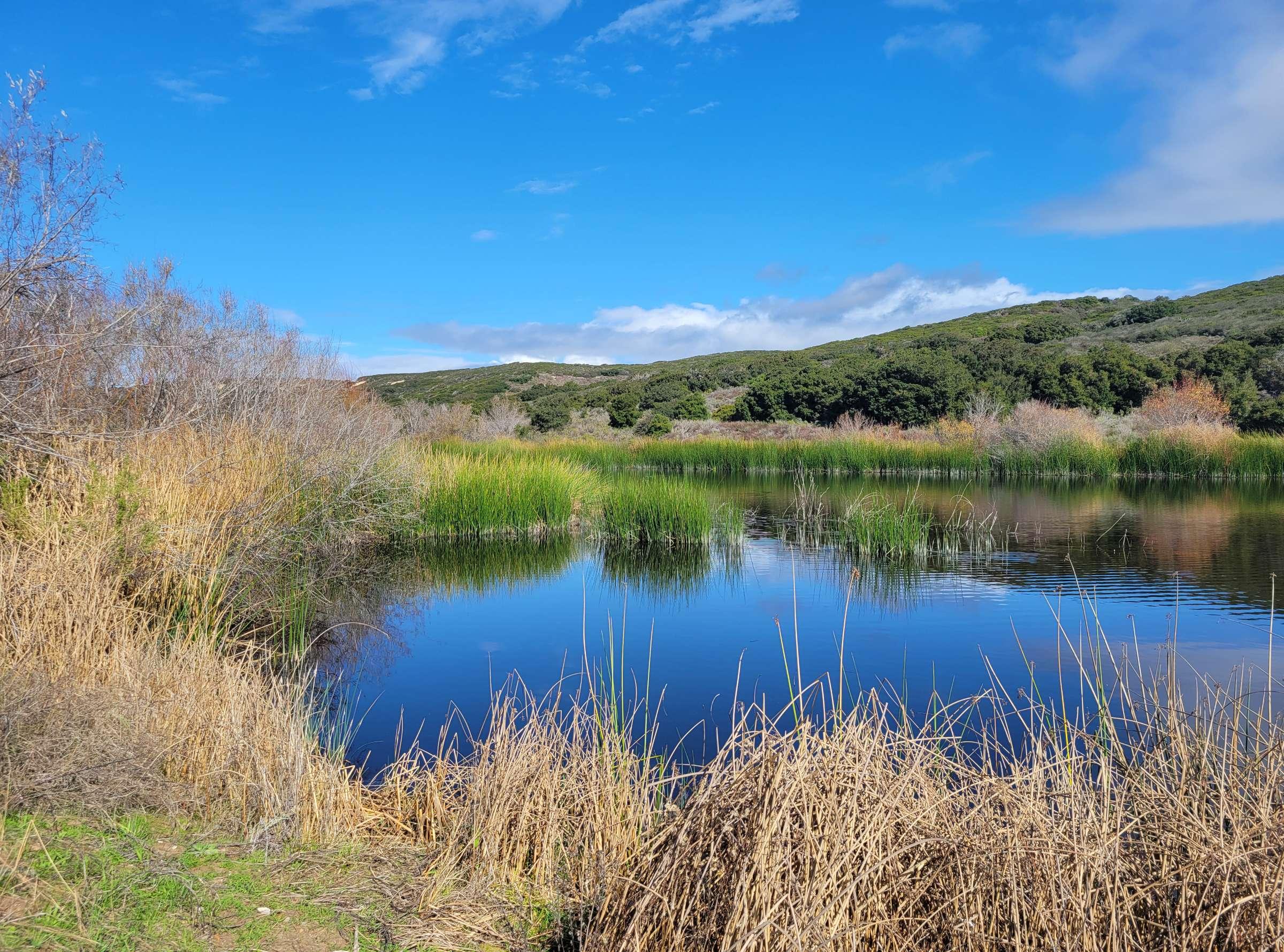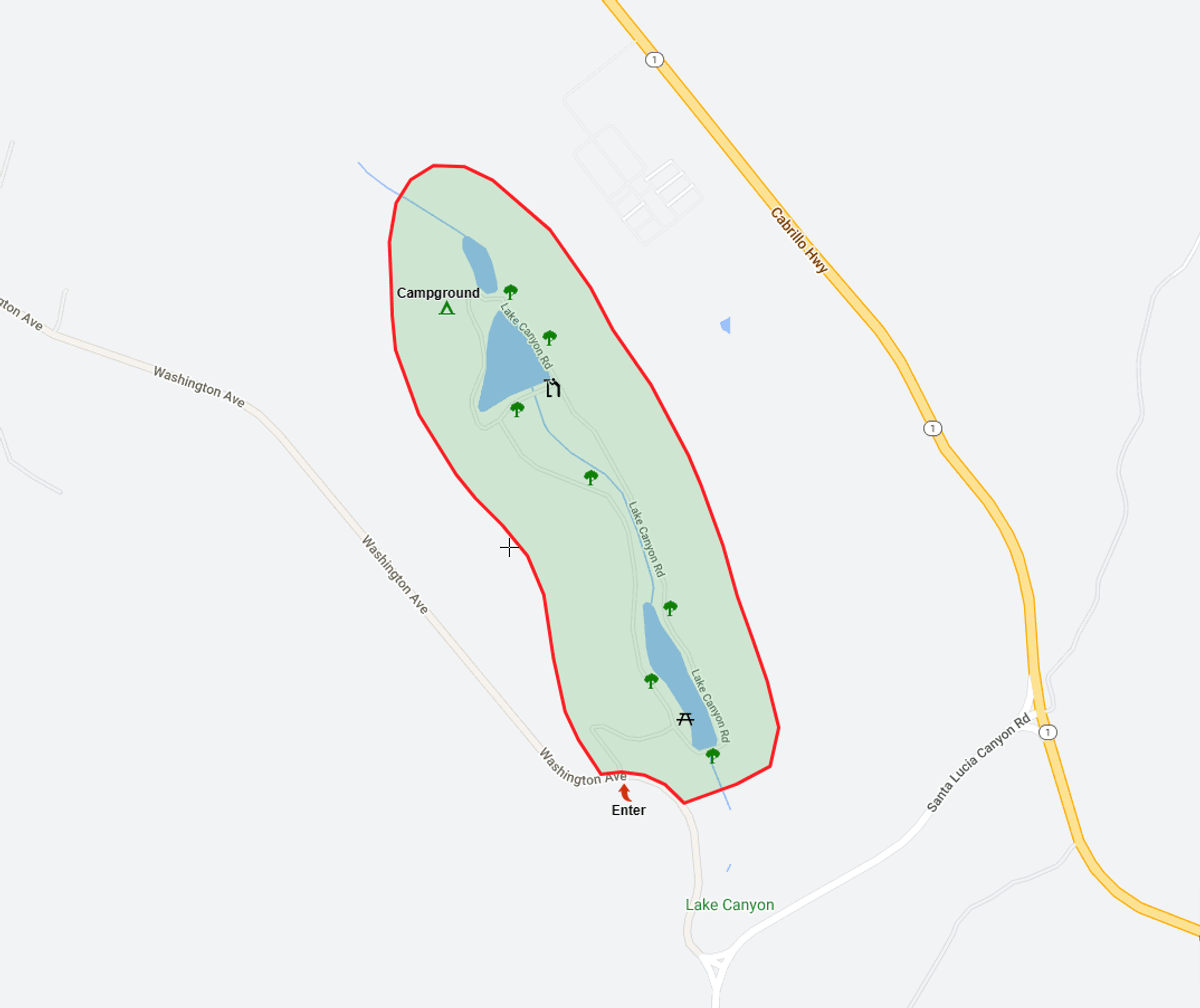Vandenberg SFB (restricted access)--Lake Canyon Ponds

Vandenberg SFB (restricted access)--Lake Canyon Ponds
VSFB Outdoor Recreation websiteTrails in Lake Canyon map
Vandenberg Space Force Base Beaches
VSFB Environmental (beach status)
Tips for Birding
The largest lake at the south end of the canyon is good for waterfowl such as Mallard, Gadwall, Cinnamon Teal, Ruddy Duck, Bufflehead, and scaup to name a few. This long lake is the largest body of water and offers the most shoreline. Other water birds include egrets, herons, Sora, and Virginia Rail in winter. The triangular lake in the center has been a historically good spot to find winter gulls, including Herring, Iceland, Short-billed, and inland Western Gulls. However, with the closure of the Vandenberg SFB landfill not far away few gulls are found here now. If enough water is present in winter and early spring gulls may return. When water levels are low there is exposed mud for shorebirds. Shorebirds typically found here include dowitchers, yellowlegs, and peeps. In winter check the large oaks and underbrush on the western side of the canyon for Hermit Thrush and Fox Sparrow.
Birds of Interest
Lake Canyon is good habitat for many local breeding species including American Coot, Hairy Woodpecker, Cooper's Hawk, Common Yellowthroat, Yellow Warbler, Wrentit, Marsh Wren, California Thrasher, Ash-throated Flycatcher, Tree Swallow, Northern Rough-winged Swallow. Migrant passerines in spring and fall can be found in the thick willows along the shoreline and in the scattered oaks. Unusual birds recorded here include Wood Duck, White-faced Ibis, and Tropical Kingbird.
About this Location
NOTE - This is a restricted access Hotspot found near the Cantonment Area of Vandenberg SFB. It is only accessible to visitors possessing a VSFB pass.
Access to Lake Canyon is from a turnoff at Washington Ave. near the Pine Canyon or Lompoc Gate into VSFB from Santa Lucia Cyn. Rd. Take the Lake Canyon turnoff and follow the road down to the southeast end of the largest lake. Look for the canopies above some picnic tables here where there is a wide area to park.
Suggested Hotspot boundaries: Include the smallest lake at the north end of Lake Canyon (north), the hills above Lake Canyon Rd. (east), include the largest lake at the south end of Lake Canyon near Washington Ave. (south), the hills above Lake Canyon (west)
The entire lake complex is made up of three separate ponds. Lake Canyon Rd., an approximately 2.8-mile loop, encircles all three lakes. The road is fairly wide and flat and is mostly dirt with a few big potholes on the east side that will need to be navigated. There is a short hilly section along the west side. The entire lake complex can be birded either by walking or driving. In some places, a spotting scope will be helpful. Cars will be few, but do drive through on occasion so pull off the road when stopped. Runners and cyclists will also be on the road at times. There is a primitive campground immediately west of the small lake at the north end of the canyon. There are a few floating docks on these ponds where you can walk out to the edge for a better view of the water and into the dense bulrushes.
There are no public restrooms available. Cell phone coverage may not be available.
Drought conditions have left water levels very low and much of the area is dry. Formerly all three ponds were full of water. You may find that only some areas will have shallow water not deep enough for waterfowl. Some birds may be present in shallow water depending on the time of year, but a good amount of rainfall will be needed to restore historic water levels.
About Vandenberg Space Force Base
See all hotspots at Vandenberg Space Force Base
Vandenberg Space Force Base is located in western Santa Barbara County and makes up a significant portion of coastal north county. VSFB totals some 99,579 acres in size and includes 42 miles of pristine, undeveloped coastline, 9,000 acres of sand dunes, and 5,000 acres of wetland habitats. The topography of Vandenberg SFB is varied and includes hills, mountains, terraces, floodplains, mesas, canyons, and rocky headlands. The highest point on VSFB is Tranquillion Peak located on south base and reaches a height of 2,297 ft. The base contains some of the highest quality coastal habitat remaining in southern or central California.
VSFB also contains a number of freshwater environments including the Santa Ynez River, San Antonio Creek and Barka Slough, Shuman, Cañada Honda, Bear, and Jalama Creeks, as well as man-made lakes. Riparian woodlands are found along these river courses and streambeds and are particularly important for migrating and nesting birds. Because of its protected nature, none of the backcountry areas of VSFB are open to the public or to any kind of development.
Coastal bluffs and rocky headlands provide important roosting and nesting habitat for a number of seabirds. Nest sites are found along cliffs and on offshore rocks along the coast from Purisima Point on north base, to Point Pedernales and Destroyer Rock, and Point Arguello on south base. Coastal access is only available at Ocean Park (Santa Ynez River Estuary), and Surf Beach to the general public. Seasonal restrictions are in place for Ocean Park, Surf, Wall, and Minuteman beaches annually from March 1 to September 30 as part of the annual program to protect the threatened Western Snowy Plover.
The main cantonment (urbanized) area of VSFB located on north base consists of residential, industrial, community service, administrative, and recreational use areas. This cantonment area lies within the restricted security zone of the base and is only accessible to personnel with a base pass. Several VSFB birding hotspots are found within this security zone and are therefore off limits to the general public, while other Hotspots are accessible to the public by county roadways but are still found within the boundaries of the base.
Vandenberg SFB hotspots can be categorized as follows:
1. Publicly accessible hotspots found within the Vandenberg SFB boundary. Birders are subject to the authority of VSFB security forces while visiting these locations. Examples of publicly accessible Hotspots include Barka Slough, Triangle Pond, and Surf Beach. These hotspots do not have "restricted access" in their names.
2. Restricted-access hotspots found within the security zone of Vandenberg SFB. These areas are only accessible to visitors possessing a VSFB pass. Examples include Lake Canyon Ponds, Brown's Beach to Lions Head, and Point Pedernales. These all have "restricted access" in their names.
Base passes will not be issued to the general public at this time and visitors must be “sponsored” onto VSFB by individuals who have this privilege. Birders are permitted to visit any of the hotspots listed as publicly accessible as described above and as indicated on the various hotspot pages found in this guide.
Features
Roadside viewing
Restrooms on site
Entrance fee
Content from Jamie Chavez
Last updated February 3, 2024
 Suggested Lake Canyon Ponds Hotspot Boundaries
Suggested Lake Canyon Ponds Hotspot Boundaries